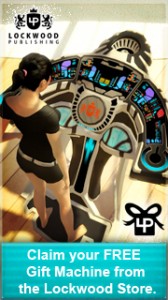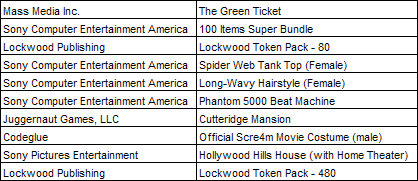SCEA Top Ten Home Items For November
Information courtesy of GlassWalls, Home Community Specialist; commentary provided by NorseGamer
Sometimes, it’s relatively easy to predict consumer trends. When a hot commodity explodes onto the Home scene, it’s a fairly safe bet you’re going to see its sales figures reflected on these top-ten lists. That said, there can also be some real surprises; even after three years of open beta, when you would expect consumer tastes and patterns to be fairly well established, there are occasional left-field curveballs that take some analysis to explain.
The beauty of Home’s economy, to me, is that its microtransaction model allows for a greater level of experimentation with lower risks. Video gaming today is much like the movie business: you’ve got an increasing percentage of revenue generated by a shrinking number of titles. And with today’s games costing astronomical sums of money — there are rumors that BioWare’s The Old Republic cost north of $100M to develop — you not only have fewer competitors able to play, but the stakes are just ungodly high. Which, frankly, can stifle creativity. No developer wants to risk tens of millions of dollars on something which could turn into the next Pluto Nash, so instead we see sequels galore.
Virtual reality and social gaming, on the other hand, is what is referred to in military terms as “asymmetric response” — the barriers to entry are much lower, and with lower stakes as well, you can see some real innovation. Couple that with huge audience exposure, and you have an emerging video game marketplace which is very, very different than what’s been dominant for the last quarter-century. “Hardcore” gamers may laugh at something as innocuous as Angry Birds, but considering it’s been downloaded half a billion times, it certainly bears asking where the true future of the industry lies.
This is one of the reasons why PlayStation Home fascinates me so; nobody’s ever tried a console-based virtual reality before, which is why it makes for such a great case study. Console gaming is traditionally the land of hardcore gamers; consoles aren’t set up to handle social gaming (if they were, they’d be bundled with keyboards), and I’ll wager the typical audience demographics might skew a bit younger. There’s so little new ground broken in the industry any more that something like Home, which really is a new venture, is fascinating to study. The lessons learnt from Home, in terms of sociological consumer behavior and return on investment, will prove to have significant ripple effects for a long time to come.
Thus, let’s take a look at November’s top-ten items (by units sold) and see what to make of it:
There are some interesting items here.
1. The Green Ticket continues to take the checkered flag in Home sales! We’ve seen other hot games come and go on these lists, but so far none of them have had the same staying power as Midway. What is it about Mass Media’s carnival games that keeps bringing in the business? Is it just that they’re so bloody simple compared to most other Home games? Or is it that the two Midway spaces offer such a variety of gaming experiences that they’re harder to grow tired of?
 2. We predicted, back when Lockwood first announced its Gift Machine, that it would be a huge hit. And we were right. People love giving gifts to each other. Couple that with regular infusions of new content — which can’t be acquired anywhere else — and you’ve got a recipe for success. Lockwood Token Packs have been a mainstay on this list for virtually all of 2011, and I doubt they’re going to fade away any time soon. The real question is whether or not other developers will jump in on the act as well.
2. We predicted, back when Lockwood first announced its Gift Machine, that it would be a huge hit. And we were right. People love giving gifts to each other. Couple that with regular infusions of new content — which can’t be acquired anywhere else — and you’ve got a recipe for success. Lockwood Token Packs have been a mainstay on this list for virtually all of 2011, and I doubt they’re going to fade away any time soon. The real question is whether or not other developers will jump in on the act as well.
3. After a bit of a conspicuous absence from the top-ten lists, female apparel is back with a vengeance, thanks to the Spider Web Tank Top and Long-Wavy Hairstyle. The only male apparel on this list is Codeglue’s Scre4m Costume, which isn’t surprising considering the recent Halloween holiday. Those of you who have been following these lists know that female apparel was consistently outperforming male apparel, until for some reason the trend went into retrograde motion and male clothing surged forward. We’ve offered various theories as to why — a reduction in Home cross-dressing, a lack of sufficiently compelling items, the possibility that female shoppers are more long-term users and thus pickier in their selections — but if we’re honest we’re just as in the dark as you are.
4. Okay, I’ll ask: why is the Phantom 5000 Beat Machine doing so well? I’ve nothing against it; I’m simply curious. We’ve seen a variety of musical items arrive in Home — and why the Scariachi Band isn’t on this list is beyond me, because it’s such an awesome item — but the one that’s made it to the top is the Phantom 5000. What does this imply about the musical tastes of Home’s population?
5. Is anyone really surprised to see the Cutteridge Estate on the list? You kinda knew it was going to be there, and with good reason: it’s just that awesome. Personal estates in Home have gotten to the point where it’s virtually a necessity to offer something different or unique; it’s no longer sufficient to simply paint a pretty setting and charge five bucks for the privilege of decorating it. Juggernaut’s first entry into the Home scene is a slam-dunk; it offers fantastic weather effects, a genuinely challenging mini-game, some excellent sound design, and — perhaps most importantly — the knowledge that it will be periodically updated with new content by the parent developer. At seven dollars a pop it’s higher than the average estate price, but certainly a justifiable investment. Likewise, the Hollywood Hills House returns to the top-ten list, likely because of its Entertainment On Demand (EOD) technology. The introduction of EOD to Home has radically expanded what the community can enjoy, but I’m also curious if these various innovations are providing downward pressure on sales of older estates, which don’t feature some of these newer innovations.
6. A random bit of idle math, since I’m in the mood: let’s assume that the average virtual commodity on this list sells roughly five-thousand transactions, and that the real megahits are somewhere in the twenty-thousand range. Let’s also average out the various prices of these items to a median of, say, two dollars and fifty cents. That means that this top-ten list grossed somewhere in the neighborhood of $175,000 to $250,000 or so for the month of November. Yes, there’s a wild margin of error here — your guess is as good as mine — but it’s certainly a fun bit of mental guesswork to figure out how much capital Home’s considerable catalogue of virtual commodities generates on a monthly basis. Obviously SCEA has more revenue streams with Home than simply microtransactions, but it’s quite fun to build hypothetical pro formas on the economic engine powering this virtual playground we enjoy.






 LinkedIn
LinkedIn Twitter
Twitter
The Cutteridge Estate was a no-brainer. If they tabulated sales figures and it didn’t enter the Top Ten, that would be a shock.
I agree with the Hollywood Hills: the “baked in” EOD TV and free movies/TV shows from Crackle are an immediate and undeniable win. It naturally attracted attention from its customers, so its inclusion in the Top Ten is this short of planned.
This list is effectively populated by sure-fire sellers. I’ll join in though on the Phantom 5000: why this one and not, say, the Scary-achi band? They are adorable in their own spooky way, plus they fit right in with the Cutteridge Estate and the music’s delightful.
I am not privy to how the numbers are tabulated, but one thing that may skew the list is if an item is released in the last week of a month, it probably has little chance of making the list. The first two weeks account for a large majority of an item’s sales. I have heard that some items get half their sales in the first month and the other half over the next 17 months or so. If the first two weeks are split over two seperate months, I imagine the item will miss both month’s top ten.
Interesting all the complaining about the Hollywood Hills and it still made the top ten after almost a year of sales. I think that says something really important -- content rules. Now I just need to get me some media rights to sell.
I’ve wondered much the same thing, actually. There are probably some item releases which slip through the metaphorical cracks because they’re released partway through the month, and thus won’t show up on the lists. A longer timescale — a quarter, or even a year — might give a somewhat more accurate picture, even though it would still be skewed in favor of earlier entries.
Content is definitely king. I’m curious as to why Hollywood Hills sold better than Sunset Yacht (which, of the two EOD-enabled spaces, is my preference). They offer different content in their respective EODs, but I’m wondering if there are just fewer people interested in a nautically-themed space.
Here’s my theory. Certain spaces appeal more to males, like the Tycoon Penthouse, Weekend Lake House and Hollywood Hills House. Since there are more males on Home, these spaces will sell better.
The SCRE4M outfit is sadly incomplete in Asia with its running animation altered and actions removed….I’ll have to pass my vote for Lockwood’s Iron Fusion Mechjets.